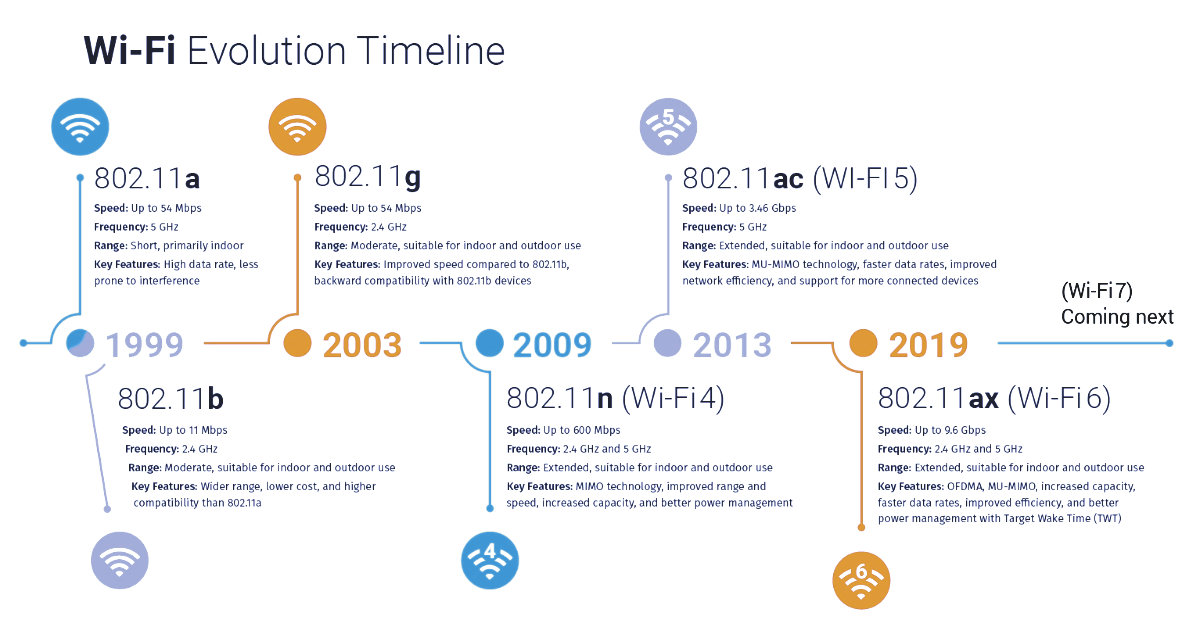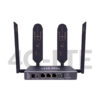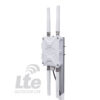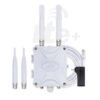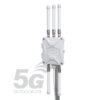SIM Router Solution, Technical Benefits
Wi-Fi 4/5/6 – How To Select Wi-Fi SIM Routers
Select Wi-Fi SIM Card Routers for Home Networks
Ever wondered what a Wi-Fi SIM router could do for you? A Wi-Fi SIM router is an all-around networking device that creates Wi-Fi networks by using a SIM card for internet access instead of a traditional cable connection. It lets you connect wherever you are by broadcasting the internet to your devices via Wi-Fi or a LAN cord.
The Wi-Fi SIM card router is a flexible solution for homes and offices without fixed cable networks or a reliable backup internet connection when primary services fail. It can be set up immediately by simply inserting a SIM card, making it ideal for temporary locations or quick deployment situations, especially in remote locations or during transitions between fixed-line services.
Comparison – Wi-Fi 4 vs. Wi-Fi 5 vs. Wi-Fi 6
The Wi-Fi SIM card routers are built with different Wi-Fi standards — from Wi-Fi 4, Wi-Fi 5, to Wi-Fi 6. Before selecting between Wi-Fi 4/5/6 SIM card routers, let’s start with their basic features.
Each Wi-Fi 4/5/6 offers a unique encoding method, code rate, channel width, transmission time, and speed rate. Each generation advances to meet increasingly complex network demands. The newer Wi-Fi generation has more features that support different connectivity needs — from simple browsing to streaming and smart home setups.
Simply speaking, Wi-Fi 4 handles basic connectivity, Wi-Fi 5 boosts multi-device performance, and Wi-Fi 6 supports high-density, high-speed environments. Let’s dive further into their working principles and comparisons and understand how to select the suitable Wi-Fi SIM card router to match your setup.
Wi-FI 4 (802.11n)
Wi-Fi 4 and wireless N are the short names of the IEEE 802.11n wireless networking standard, the fourth-generation Wi-Fi standard launched in 2009. It introduced significant advancements, notably MIMO (Multiple Input, Multiple Output) technology, which enabled multiple simultaneous data streams, boosting throughput and network efficiency.
Wi-Fi 4 SIM router supports a moderate range and data rate — up to 300 Mbps on 20MHz channels and 600 Mbps on 40MHz channels. It is suitable for basic web surfing and few device streaming needs, such as low traffic demand terminals, including IoT sensors, industrial machines, legacy Wi-Fi enabled equipments, and so on.
Wi-Fi 5 (802.11ac)
Wi-Fi 5, or 802.11ac, was released in 2013 and marked a substantial advancement over Wi-Fi 4. Its exclusive use of the 5 GHz band offers reduced interference and higher capacity. Increased maximum speeds to 1.3 Gbps on single 80 MHz channels, Wi-Fi 5 supports up to 8 MIMO streams and connects multiple devices with minimal performance degradation.
Enhancements like 256-QAM modulation for Wi-Fi SIM routers mean better support for multiple devices and higher speeds, making Wi-Fi 5 ideal for moderate usage, such as 4K video streaming, online gaming, and households with multiple connected devices.
Wi-Fi 6 (802.11ax)
Wi-Fi 6, or 802.11ax, is the sixth-generation Wi-Fi standard, officially released in 2019. Designed to operate on both 2.4 GHz and 5 GHz bands, Wi-Fi 6 addresses the growing demand for high-bandwidth applications that require speeds of up to 200 Mbps. To meet these requirements, Wi-Fi 6 significantly increases data transfer rates and reduces network latency, making it well-suited for high-density, multi-device environments.
With a maximum theoretical speed of 9.6 Gbps, Wi-Fi 6 achieves advanced efficiency for multi-device setups through technologies like OFDMA, 1024-QAM, and MU-MIMO. Wi-Fi 6 SIM routers leverage these capabilities to provide optimal performance for high-bandwidth activities such as 4K streaming, smart home integration, and IoT applications, ensuring a fast and reliable connection even in complex network setups.
Wi-Fi 4/5/6 Technical Specification Chart
| Category | Wi-Fi 4 (802.11n) | Wi-Fi 5 (802.11ac) | Wi-Fi 6 (802.11ax) |
| Standard Released | 2009 | 2013 | 2019 |
| Frequency Bands | 2.4 GHz | 5 GHz | 2.4 GHz, 5 GHz |
| Max Channel Bandwidth | 40 MHz | 80 MHz | 160 MHz |
| Modulation | 64-QAM | 256-QAM | 1024-QAM |
| Bits per Symbol | 6 | 8 | 10 |
| Max Code Rate | 45355 | 45418 | 45418 |
| Effective Data | 0.75% | 0.833% | 0.83% |
| Max Effective Subcarriers (20MHz) | 108 | 234 | 1960 |
| Channel Widths Supported | 20 MHz, 40 MHz | 20 MHz, 40 MHz, 80 MHz | 20 MHz, 40 MHz, 80 MHz, 160 MHz |
| Symbols per Second | 31250 | 62500 | 73529 |
| Spatial Streams | 4×4 MIMO | 4×4 MU-MIMO | 8×8 MU-MIMO |
| Theoretical Peak Speed | 600 Mbps | 3.5 Gbps | 9.6 Gbps |
| Symbol Transmission Time | 3.6 μs | 3.6 μs | 13.6 μs |
| Guard Interval (GI) | 0.8 μs | 0.8 μs | 0.8 μs |
| 2x GI | 1.6 μs | 1.6 μs | 1.6 μs |
| 4x GI | 3.2 μs | 3.2 μs | 14.4 μs |
| Ideal Use Cases | Basic browsing, few-device | HD streaming, gaming, multi-device | 4K/8K streaming, IoT, high-density areas |
How to Select Wi-Fi 4/5/6 SIM Routers?
Before selecting a Wi-Fi SIM router, it helps to know which version of Wi-Fi 4/5/6 is best suited for various applications and Wi-Fi enabled devices.
(802.11n) Wi-Fi 4 SIM Router
- Transmission Medium: Wi-Fi 4 operates primarily on the 2.4GHz band, offering decent range but limited bandwidth.
- Channels and Bandwidth: It uses 20 MHz channels and supports 40 MHz for reaching up to 600 Mbps in ideal conditions.
- MIMO Technology: Wi-Fi 4 introduced 2×2 MIMO (Multiple Input, Multiple Output), allowing multiple data streams and moderate improvements in speed and coverage.
(802.11ac) Wi-Fi 5 SIM Router
The Wi-Fi 5 SIM router is ideal for households or small businesses that need reliable and affordable connectivity. It also supports Wi-Fi 4 mode. After turn on Wi-Fi 5 hotspot, it seamlessly supports moderate demands such as video streaming, light gaming, or multiple devices connected simultaneously. With flexibility and performance built-in, these routers provide stable, budget-friendly solutions tailored to your specific usage needs.
- 5 GHz Band: Operates exclusively on 5 GHz, reducing interference and enhancing data rates.
- Increased Bandwidth: Supports up to 80MHz channel widths with theoretical speeds reaching 1.3 Gbps.
- 256-QAM Modulation: This higher modulation level improves data density and speed, allowing each symbol to carry 8 bits.
(802.11ax) Wi-Fi 6 SIM Router
1024-QAM Modulation: The Wi-Fi 6 router uses 1024-QAM modulation, which enables each symbol to carry 10 bits and enhances data throughput, making Wi-Fi 6 suitable for high-data-demand applications and faster data throughputs.
OFDMA (Orthogonal Frequency Division Multiple Access): Dividing channels into smaller sub-channels, OFDMA allows simultaneous data streams for multiple devices, improving efficiency and reducing latency. It is especially effective in high-density environments where multiple devices need simultaneous connections.
MU-MIMO: Wi-Fi 6 supports 8×8 MU-MIMO for both uplink and downlink, enabling concurrent connections with multiple devices and reducing network congestion. It is ideal for applications requiring parallel data streams, such as video conferencing and multiplayer online gaming.
160MHz Channel Bandwidth: Wi-Fi 6 supports up to 160MHz channel width, doubling throughput in high-bandwidth applications. This makes it ideal for applications with low latency and fast speeds.
Target Wake Time (TWT): TWT reduces device wake-up frequency, lowering power consumption and extending battery life. It especially benefits IoT devices like smart home systems and sensor networks.
BSS Coloring: This feature mitigates interference by marking overlapping networks, enhancing overall network efficiency. It is highly useful in densely populated areas with overlapping networks, such as apartment buildings and office complexes.
Developed with the best wireless performance, OutdoorRouter builds Wi-Fi SIM routers with backward compatibility. The higher-grade Wi-Fi supports downgraded wireless standards. For example, the Wi-Fi 5 router also creates Wi-Fi 4 hotspots on 2.4 GHz, and the Wi-Fi 6 router supports Wi-Fi 4/5 connections.
Selecting a suitable Wi-Fi 4/5/6 SIM router can significantly affect your internet experience, whether you’re handling basic web surfing, video streaming, or running a smart home. Suggest considering the specific Wi-Fi version that aligns with your requirements, device compatibility, and network demands. Be sure to review the model specifications to match your needs for frequency range, data rate, and device capacity.
For tailored advice on which Wi-Fi SIM router best fits your setup, or if you have questions about maximizing performance in your environment, please feel free to contact us. We’re here to help you find the ideal solution for stable connectivity.


